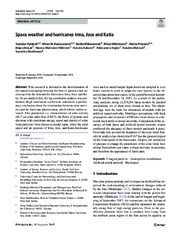Приказ основних података о документу
Space weather and hurricanes Irma, Jose and Katia
| dc.contributor | Brinks, Elias | |
| dc.creator | Vyklyuk, Yaroslav | |
| dc.creator | Radovanović, Milan M. | |
| dc.creator | Milovanović, Boško | |
| dc.creator | Milenković, Milan | |
| dc.creator | Petrović, Marko | |
| dc.creator | Doljak, Dejan | |
| dc.creator | Malinović-Milićević, Slavica | |
| dc.creator | Vuković, Natalia | |
| dc.creator | Vujko, Aleksandra | |
| dc.creator | Matsiuk, Nataliia | |
| dc.creator | Mukherjee, Saumitra | |
| dc.date.accessioned | 2022-11-14T12:21:33Z | |
| dc.date.available | 2022-11-14T12:21:33Z | |
| dc.date.issued | 2019 | |
| dc.identifier.issn | 0004-640X | |
| dc.identifier.uri | https://dais.sanu.ac.rs/123456789/13408 | |
| dc.description.abstract | This research is devoted to the determination of the causal relationship between the flow of particles that are coming from the Sun and the hurricanes Irma, Jose, and Katia. To accomplish this, the lag correlation analysis was performed. High correlation coefficients confirmed a preliminary conclusion about the relationship between solar activities and the hurricane phenomenon, which allows further research. Five parameters i.e. characteristics of solar activity (10.7 cm solar radio flux (F10.7), the flows of protons and electrons with maximum energy, speed and density of solar wind particles) were chosen as model input, while the wind speed and air pressure of Irma, Jose, and Katia hurricanes were used as model output. Input data were sampled to a six hours interval in order to adapt the time interval to the observed data about hurricanes, in the period between September 28 and December 21, 2017. As a result of the preliminary analysis, using 12,274,264 linear models by parallel calculations, six of them were chosen as best. The identified lags were the basis for refinement of models with the artificial neural networks. Multilayer perceptrons with back propagation and recurrent LSTM have been chosen as commonly used artificial neural networks. Comparison of the accuracy of both linear and artificial neural networks results confirmed the adequacy of these models and made it possible to take into account the dynamics of the solar wind. Sensitivity analysis has shown that F10.7 has the greatest impact on the wind speed of the hurricanes. Despite low sensitivity of pressure to change the parameters of the solar wind, their strong fluctuations can cause a sharp decrease in pressure, and therefore the appearance of hurricanes. | sr |
| dc.language.iso | en | sr |
| dc.publisher | Switzerland : Springer Nature | sr |
| dc.relation | info:eu-repo/grantAgreement/MESTD/Integrated and Interdisciplinary Research (IIR or III)/47007/RS// | sr |
| dc.rights | openAccess | sr |
| dc.rights.uri | https://creativecommons.org/licenses/by-nc-nd/4.0/ | |
| dc.source | Astrophysics and Space Science | sr |
| dc.subject | charged particles | sr |
| dc.subject | atmospheric disturbances | sr |
| dc.subject | artificial neural network | sr |
| dc.subject | hurricanes | sr |
| dc.title | Space weather and hurricanes Irma, Jose and Katia | sr |
| dc.type | article | sr |
| dc.rights.license | BY-NC-ND | sr |
| dc.citation.volume | 364 | |
| dc.citation.issue | 154 | |
| dc.identifier.wos | 000486264300003 | |
| dc.identifier.doi | 10.1007/s10509-019-3646-5 | |
| dc.identifier.scopus | 2-s2.0-85073049971 | |
| dc.type.version | publishedVersion | sr |
| dc.identifier.fulltext | http://dais.sanu.ac.rs/bitstream/id/53464/M22_2019_AstrophysSpaceSci.pdf | |
| dc.identifier.rcub | https://hdl.handle.net/21.15107/rcub_dais_13408 |

